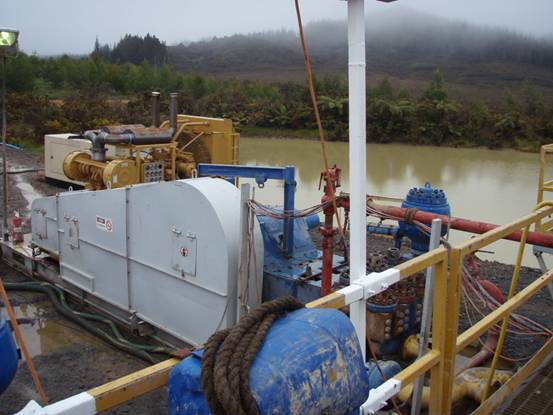13.4 What is being done?
The Ngawha geothermal field is currently "tapped" by a single user – Ngawha Geothermal Resource Company Ltd, which operates a small scale power station that generates around 11 MW (gross) of electricity, and is currently undertaking expansion of the plant to increase production to 25 MW (gross).
As discussed in the previous section, the resource consents granted in 1994 for the power station required the consent holder to undertake baseline monitoring in the Ngawha area before it could start taking geothermal fluid. In addition to this monitoring, the resource consents also:
· Restricted the take to 10,000 tonnes per day instead of the 35,000 tonnes per day originally applied for by the joint venture.
· Required comprehensive ongoing monitoring of the environmental effects of the geothermal fluid take and power station.
· Required the establishment of a "Peer Review Panel". This panel is made up of three professionals with expertise in geothermal reservoir management, geothermal chemistry, and terrestrial and aquatic ecology, and a representative of the tangata whenua. The main purpose of the panel is to critically review reports on the various monitoring programmes required by the consents, consent compliance and the effects of the take/operation of the power station on the surrounding environment, and the sustainability and characteristics of the Ngawha geothermal field.
· Required the establishment of a "Community Liaison Committee" made up of representatives of the tangata whenua of Ngawha, thermal pool operators, local residents, downstream water users and the Far North District Council and Northland Regional Council.
The term of the consents was also reduced to 10 years (from the commencement of the consents) instead of the 35 years applied for.
These strict requirements were imposed on the resource consents to:
· Protect the geothermal springs/features in the Ngawha Basin and the sustainability and characteristics of the Ngawha geothermal field.
· Minimise any environmental effects of the take and power station.
The new consents granted in November 2006 include continuation of all of the above requirements, except that:
· The take has been increased to approximately 25,000 tonnes per day (775,000 tonnes per month),
· The term of the consents is for 20 years, with provision to review under Section 128 of the RMA, and
· Further baseline and ongoing monitoring of the receiving environment is required in new areas proposed to be used in the expansion.
The new consents also require the consent holder to maintain pressure of the geothermal reservoir within +1.5 bar and -1 bar of the existing reservoir pressure. In order for the consent holder to maintain this pressure and avoid effects on the geothermal springs, the consents include re-injection of the fluid extracted and injection of an additional 3000 tonnes of water per day to maintain the pressure in the geothermal reservoir.

Part of the drilling equipment with discharge pond in background.
Monitoring
Monitoring over the 10-year term of the previous consent has shown that no significant changes to the local environment have occurred in terms of air, water and soil quality that could be attributed to the discharges from the power station over the period of its operation.
Over the period of the previous consent, monitoring was conducted for:
· Ecosystems (including receiving water quality, vegetation surveys and surveys of eels (Anguilla sp.), mudfish and other fauna).
· Springs and streams receiving thermal fluids (bath temperature and chemistry, stream flow variations).
· Groundwater (levels, temperature and chemistry).
· Temperature and pressures in the geothermal reservoir.
· Lakes (levels, temperatures and chemistry).
· Air quality (chemistry).
A survey of the wetland area immediately below the outlet from the NG9 holding pond in September 1999 established that some vegetation had been damaged or killed as a result of early discharges from the pond. These areas have since recovered (Silvester 1999).
The Pond Management Plan (NZE 2007a) for the expanded power plant includes re-injection of almost all wastewater generated during operation and maintenance activities. This reduces the need for discharges from the ponds and enables protection of the potentially sensitive receiving environment, which is a habitat for the critically endangered black mudfish species.
Some Ngawha residents and geothermal pool operators have raised concerns that there may have been some cooling of the pools. However, comparison of long-term temperature records did not show any cooling of the spring outside of natural variation. Reservoir modelling and additional investigations undertaken indicate that maintenance of reservoir pressure will mitigate adverse effects on spring flows, temperature and chemical composition.
Concerns have also been raised about offensive odour, which has been attributed to the power station. Continuous hydrogen sulphide monitoring records confirm that there have been high levels recorded, but that those levels were not outside the range recorded during the baseline monitoring period.
Ongoing comprehensive monitoring is required as a condition of the consent to ensure that no adverse effects on the springs occur as a result of the increased extraction.
A revised environmental monitoring programme has been developed in accordance with the requirements of conditions in the new consents, and the area of monitoring has been expanded to include the wider area affected by the expansion of the power station (NZE 2007b). Monitoring frequency is dependent upon the specific type of monitoring and the activities occurring at the site and ranges from, for example, daily monitoring in the event of any pond discharge to monthly and six-monthly chemical monitoring of streams and of geothermal features including the springs, and annual ecological monitoring.
Reporting of the results will continue to be six-monthly, and results will be reviewed by the Peer Review Panel, as well as by Regional Council staff. In the event of any discharges to the receiving environment, reporting will be undertaken at the time of, and throughout the duration of, the discharge to enable Regional Council compliance monitoring and liaison with respect to any recommended actions, if required. During the construction phase of the expanded power station additional monitoring has been undertaken to minimise and mitigate any environmental effects.
